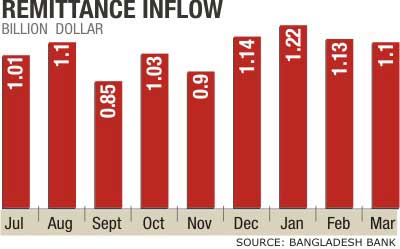Slight fall in remittance Full-year outlook bright: analysts

Inward remittances fell 1.77 percent to $1.11 billion in March from a month ago, but analysts projected a bright outlook for 2012.
More than $1 billion was remitted from abroad by Bangladesh's migrant workers every month, except September and November, in the first nine months of the current fiscal year, according to data from the central bank.
In February, the remittance inflow stood at $1.13 billion. Remittance increased by 11 percent to $9.53 billion in the first nine months of current fiscal year.
The banking regulator projected that remittance will be worth around $13 billion in the current fiscal year, which will have a positive impact on the country's balance of payments, a Bangladesh Bank official said.
The official said the good flow of remittance had already made the foreign currency reserve and exchange rate stable in recent times.
The exchange rate in the inter-bank foreign exchange market hovered around Tk 82 against the dollar last month, which was over Tk 85 a month ago.
In its economic analysis, BRAC EPL Stock Brokerage Ltd said there are several local, regional and global forces at play that seem to have come together for a good remittance inflow into Bangladesh.
The depreciation of the taka, the central bank's initiatives and an increase in oil prices indicated a bright future for the remittance inflow in 2012, according to the BRAC EPL analysis.
The analysis said as workers sent more foreign currency home to take advantage of the weakening local currency, the number of workers migrating also increased significantly, in fact, by 68.5 percent in the first six months of 2011-12.
At the policy level, BB quickened the process by which local banks secure permissions to sign deals with overseas money transfer companies, according to the analysis.
"This is expected to divert the remittance flow away from unofficial 'hundi' channels towards bank-arranged transfers."
In the context of the local banking industry, the business of remittance is also heating up, as more private commercial banks have entered the business and set up exchange houses in Singapore, UK, and the Middle East, BRAC EPL said.
Oil prices are above $125 a barrel, partly pricing in fears of a war between Iran and Israel, and partly because the global economy is on a sounder footing than in 2010-11, it said.
When oil prices rise, the GCC countries increase construction and other economic activities, which in turn increases demand for migrant workers, it said.
In the aftermath of the Arab Spring, certain Arab states are witnessing stabilising political climates. An example is Libya that is beginning to witness rebuilding activities following the extended unrest there, leading to a revival of demand for Bangladeshi migrant workers.
In Southeast Asia, Malaysia is expec-ted to increase the intake of Bangla-deshi migrant workers significantly, after a period of lull. Labour migration to Malaysia is expected to materialise by fiscal 2014 and around that time, Qatar is expected to join the list of Bangladeshi manpower importers.
Considerable construction activities are expected to ensue in Qatar in light of its host status for Fifa World Cup 2022.
In the composition of migrant labour population, one new dimension is female participation, which is going to play a positive role in remittance inflow in the future, BRAC EPL said.
The report said female participation is on the rise owing to increased demand for domestic help in the GCC countries. On average, the participation of female migrant workers grew at an average annual rate of 4.8 percent in fiscal 2004-11.
In fiscal 2010, the number of female migrants recorded robust growth of 6.5 percent year on year, and in fiscal 2011, an impressive 7 percent, the report said.
The Daily Star/Bangladesh/ 3rd April 2012




Comments